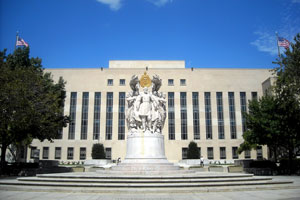The latest technology to capture the attention of law enforcement is called ShotSpotter. The manufacturer claims that hidden microphones installed in neighborhoods can tell the difference between gunshots and other loud noises. Rather than waiting for someone to report a shooting, police agencies that rely on the technology dispatch officers to the location where the shots were allegedly fired.
The technology has generated criticism. Apart from concerns about the concentration of microphones in black neighborhoods, the Electronic Frontier Foundation is worried that police agencies might use the microphones to eavesdrop on private conversations. Whether the ShotSpotter system reduces gun violence seems doubtful.
From the standpoint of an expert witness blog, the question is whether defense attorneys should use expert witnesses to challenge ShotSpotter evidence in court. There is good reason to think that Daubert challenges should be filed, and experts employed, whenever ShotSpotter evidence is a critical component of the prosecution’s proof.
Investigations of ShotSpotter
A recent investigation calls into question the evidentiary value of ShotSpotter reports. Last year, Michael Williams brought a shooting victim to a Chicago hospital. Williams said the victim was shot during a drive-by shooting. After the victim died, the police arrested Williams for the victim’s murder. Why Williams would bring the victim to a hospital if Williams intended to kill him is a question that raises serious doubt about Williams’ guilt.
The police built their case on video and ShotSpotter evidence. The video evidence showed only that Williams’ car had stopped in the 6300 block of South Stony Island Avenue at 11:46 p.m. on the night of the shooting. The police contended that the victim was shot at that location. No video evidence supports that contention.
The police contend that they received a “shots fired” alert from ShotSpotter at the Stoney Island location. In fact, company records show that “19 ShotSpotter sensors detected a percussive sound at 11:46 p.m. and determined the location to be 5700 South Lake Shore Drive—a mile away from the site where prosecutors say Williams committed the murder.” The company’s algorithms identified the sound as an exploding firework.
Company records show that “a ShotSpotter analyst manually overrode the algorithms and ‘reclassified’ the sound as a gunshot.” Months later, a different ShotSpotter employee manually changed the alert’s coordinates to a South Stony Island Drive location near the place where Williams’ car can be seen on camera.
The evidence suggests that ShotSpotter changed its data to support the theory that Williams shot the victim. Williams’ lawyer filed a motion that challenged the ShotSpotter evidence, arguing that it failed to meet the Illinois standard for the admissibility of expert opinions. Rather than defending against the motion, prosecutors agreed not to use ShotSpotter evidence against Williams.
Daubert Challenges to ShotSpotter Evidence
The investigation suggests that the Chicago incident was not an isolated example of ShotSpotter tailoring its conclusions to match law enforcement theories. In a carefully worded statement, ShotSpotter denied that it has ever “altered the information in a court-admissible detailed forensic report based on fitting a police narrative.” The statement claims that ShotSpotter is “100{d61575bddc780c1d4ab39ab904bf25755f3b8d1434703a303cf443ba00f43fa4} accurate,” a claim of certainty that many reputable forensic science experts condemn. The statement asserts that ShotSpotter has been admitted over ten Frye challenges and one Daubert challenge, but it does not state how many challenges to admissibility have succeeded.
ShotSpotter commissioned a report by CSG Analysis, a “police officer-owned and operated company,” that is filled with unsurprising praise of ShotSpotter. The report does not purport to be based on a scientific analysis. Rather, it is based on interviews with police officers in cities that have paid to install ShotSpotter.
Despite the report’s obvious credibility issues, the authors acknowledge that false positives — sounds that could be caused by trucks, dumpsters, construction, church bells, and all the other sources of concussive sound — are a significant operational problem with ShotSpotter. In two of the seven jurisdictions where interviews were conducted, half of the ShotSpotter alerts were believed to be false positives. A recent study found that Chicago police officers investigated 40,000 ShotSpotter alerts in a 21-month period that resulted in no evidence that shots had been fired.
Challenges to ShotSpotter Evidence
ShotSpotter claims that its analysts can identify actual gunshots when evidence is needed for court. The analysts allegedly perform a deeper dive into the data than the system’s algorithms perform. ShotSpotter contends that a more reliable human analysis explains why results are changed after police agencies contact ShotSpotter. Since one purpose of algorithms is to eliminate human bias, one might wonder whether second-guessing algorithms calls either the algorithms or the analyst’s opinions into question.
The admissibility of ShotSpotter evidence, whether generated by algorithms or humans, is not a foregone conclusion. A Daubert challenge should focus on whether ShotSpotter results been accepted by any independent scientific community, whether its analytical system has been peer reviewed, whether it has a known error rate, and whether conclusions drawn by analysts have been verified by independent testing. The National Juvenile Defender Center has compiled materials, including transcripts of testimony that ShotSpotter witnesses have given at Daubert/Frye hearings, that may guide those challenges.
Notably, a California appellate court reversed a conviction based on ShotSpotter evidence because the trial court did not hold a pretrial hearing to determine whether the evidence was reliable. The court noted the dearth of appellate opinions considering the admissibility of ShotSpotter evidence and concluded that courts could not assume the reliability of the novel technology.
ShotSpotter offers to supply prosecutors with expert witnesses who will testify in court for $350 an hour with a two-hour minimum. Retaining a defense expert with a background in acoustic science may be critical to countering those experts and to bringing a successful Daubert challenge.






